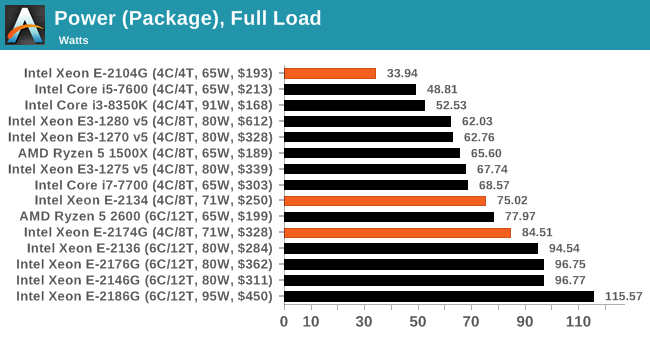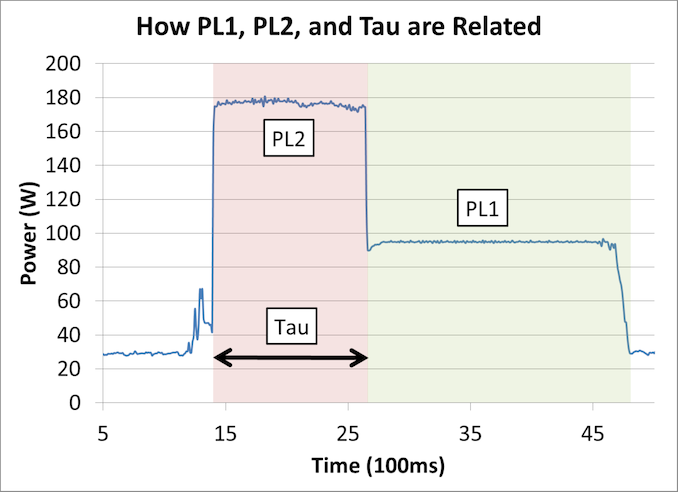The Xeon Entry Quad-Core CPU Review: Xeon E-2174G, E-2134, and E-2104G Tested
by Ian Cutress on March 11, 2019 10:30 AM EST- Posted in
- CPUs
- Xeon
- Enterprise CPUs
- Coffee Lake
- Xeon E
- C246
Power Consumption
Users who normally deal with consumer processors will likely know that consumer processors in consumer motherboards, especially for Intel, can consume a lot more power than their TDP rating. This is because Thermal Design Power (TDP) is not strictly a measure of power consumption, but of cooling performance required. Both Intel and AMD treat the TDP rating differently - for AMD is relates to peak performance when all cores are loaded, but for Intel it becomes related to the long-term steady state performance.
Intel defines several power levels (PL) for its processors, but the key ones are PL1 and PL2: the power level for sustained performance and the power level for short term turbo performance respectively. Normally PL1 is equal to the TDP, and PL2 is set to 1.25x the PL1. A CPU will also have a time parameter defined, telling the system how long PL2 is sustained before PL1 kicks in. It looks like this:
I wrote an article going deep into this issue, and it is worth reading for anyone interested in how turbo, performance, and power are related. Here is the link:
https://www.anandtech.com/show/13544/why-intel-processors-draw-more-power-than-expected-tdp-turbo
So these values, PL1, PL2, and the time variable, are all configurable by the motherboard manufacturer. Whatever Intel states as the recommended value can be overridden, and motherboard manufacturers often exchange better sustained frequencies for more power if the board is designed above Intel’s base specifications.
This matters when looking at consumer and commercial productions. Consumer hardware, such as the Core i3, i5, i7, and i9 processors, when paired with a consumer motherboard, often ignore PL1 and run at PL2 levels of performance all day. This enables users of those motherboards to perform long tasks quicker, because the motherboard manufacturer has designed for it.
For commercial systems, such as Xeon E, we find that motherboard manufacturers prefer to adhere to the power profiles rigidly. In this market, Intel guarantees performance with defined parameters, and this market typically insists on staying within those specifications. This means that for two processors equal in specifications but one is consumer and one is commercial, the commercial one will be lower power but perform worse in long tests. This is by and large what we have seen in our benchmarks, and our power testing.

For short intervals, for the parts that go anywhere near any power limits, these Xeon E processors go up to their PL2 values, up to 100W, but then fall back to TDP values. However, the E-2104G does not have hyperthreading, so doesn't actually ever go near those PL1 or PL2 values, making it a very efficient part.











29 Comments
View All Comments
artk2219 - Tuesday, March 12, 2019 - link
In what world is a GTX 1080 antiquated? Sure its not an RTX 2070+ but that doesn't mean its not in the same performance class. Especially since there is very little consumer software that supports raytracing.ondma - Tuesday, March 12, 2019 - link
In the world of testing *CPU* performance, where you want to most powerful gpu available to minimize gpu limitations. The 1080 is almost 3 years old, and even worse it is a vanilla 1080, not even the most powerful of its own generation, much less the new generation.bananaforscale - Saturday, March 16, 2019 - link
It's also common to all the test setups. If the GPU was changed to an RTX 2080Ti AT would have to benchmark all the systems again. Also, Xeons don't go into gaming systems, so the benefit would be questionable. Sure, you are right, but in a way that's kinda irrelevant.Foeketijn - Tuesday, March 12, 2019 - link
If only Supermicro/Tyan etc, would make an AM4 board. I would probably stop buying xeons. 24/7 build quality, IPMI, ECC and a 2D videocard and they have a new customer.I build two AM4 semi WS's and was reminded why I stopped messing around with consumer motherboards. Surprises everywhere. Bios hickups, misuse of power connections etc.
RSAUser - Monday, March 11, 2019 - link
These are Xeons, can't we add benchmarks like hosting a site and seeing how many requests it can handle? You know, things Xeons are actually used for (very rarely for gaming...)?That Wattage graph is great, no wattage/performance graph? Xeon lineup, as you stated, usually has strict power requirements, so I'd like to know the performance of those tests based on the power usage.
And why is there not Thread Ripper if that is the primary line-up these processors are competing with at that price range + ECC memory? (Even though the R5/7 seem to support ECC unofficially depending on the motherboard vendor)
SaturnusDK - Monday, March 11, 2019 - link
If in doubt. All Asrock AM4 MBs support unbuffered ECC RAM. All of them.mode_13h - Monday, March 11, 2019 - link
Thanks.GNUminex_l_cowsay - Monday, March 11, 2019 - link
Naming a level of graphics settings, IGP, was a bad idea. Frame rates in Civ6 are an uninformative metric of CPU performance, even for the purpose of playing Civ6.mczak - Monday, March 11, 2019 - link
The conclusion why the E-2104G doesn't reach its TDP is very much incorrect. Most of that delta to the other chips will be due to the low clocks (without turbo), only a small fraction of it will be due to missing HT.(And, FWIW, if you want to really see the max power, you'd also have to run a 3d app like furmark simultaneously, I don't think this was done. Possibly for the other chips it wouldn't make much of a difference, if they stick to their limits, but I'm pretty sure for the e-2104G the power draw would increase substantially. Of course though there's merit in full cpuload only power too, but this isn't the maximum the chip will use.)
mooninite - Monday, March 11, 2019 - link
You should add a section about how to buy these CPUs because they're not retail CPUs. Newegg had them listed for about a month before taking them off.Since these are marketed as workstation / entry-server chips why are there no video encoding, SQL, or Java/PHP processing benchmarks?
Video encoding in particular (VP9) using VAAPI would be helpful.